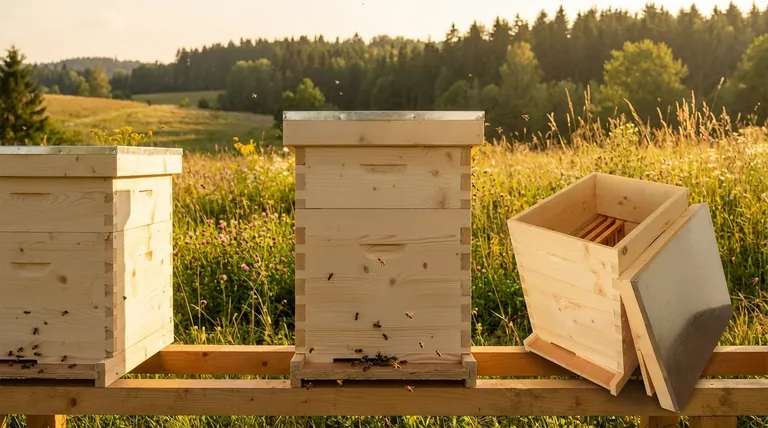The primary advantages of wooden bee hives stem from their natural material, excellent insulation properties, and practical modularity. Wood creates a breathable, temperature-stable environment that mimics a bee's natural habitat, while its standardized, repairable components offer beekeepers unmatched flexibility and long-term value.
While modern materials offer alternatives, traditional wooden hives remain the benchmark in beekeeping because they provide the best overall balance of bee health, beekeeper practicality, and environmental sustainability.

Prioritizing Bee Health and Comfort
The material of a hive directly impacts the colony's ability to thrive. Wood offers distinct biological advantages that create a healthier, more productive environment for bees.
A Natural and Familiar Environment
Wood is a natural material that closely mimics the hollow trees bees have evolved to inhabit for millions of years. This familiarity reduces stress on the colony.
The texture and scent of wood are natural to bees, creating a comfortable and accepted habitat from the moment a colony is introduced.
Superior Insulation and Breathability
Wood is an excellent insulator, helping the colony maintain a stable internal temperature. This is crucial for surviving cold winters and keeping cool during hot summers, reducing the energy bees must expend on thermoregulation.
Unlike plastic, wood is breathable. It allows for the gradual exchange of air and moisture, which helps prevent condensation buildup and reduces the risk of mold and other diseases within the hive.
Practical Benefits for the Beekeeper
Beyond bee health, wooden hives provide significant functional advantages that make management, maintenance, and long-term planning more efficient.
Unmatched Modularity and Customization
The vast majority of wooden hives, particularly the Langstroth design, are built to standardized dimensions. This means boxes, frames, and other components from different manufacturers are typically interchangeable.
This modularity allows you to easily expand your operation, replace individual damaged parts, or disassemble entire hives for compact storage during the off-season. Wood can also be easily modified with simple tools to add entrances, ventilation, or other custom features.
Long-Term Durability
With proper care, a wooden hive can last for decades. A solid coat of exterior-grade paint protects the wood from rain and sun, preventing rot and degradation.
This longevity makes a wooden hive a cost-effective long-term investment, as it will outlast many less durable alternatives with minimal upkeep.
Sourcing and Availability
Wooden hive components are the industry standard and are readily available from countless beekeeping suppliers and even local lumberyards. This wide availability protects you from supply chain disruptions and makes sourcing replacement parts simple.
Understanding the Trade-offs
No hive material is perfect. To make an informed choice, it's critical to weigh wood's advantages against its known limitations.
The Burden of Maintenance
The single biggest drawback of wood is its need for maintenance. Unprotected wood will rot when exposed to the elements. You must be prepared to paint or apply a protective finish to all exterior surfaces before use and reapply it every few years.
The Question of Weight
Wooden hives are heavy, and they become significantly heavier when full of bees, brood, and honey. A deep hive body full of honey can weigh over 80 pounds (36 kg), which can be a serious challenge for some beekeepers.
Initial vs. Long-Term Cost
While basic wooden hive kits are often among the cheapest entry points into beekeeping, the costs can add up. The need for paint, potential repairs, and the higher price of certain wood types like cedar can influence the total cost of ownership over time.
Making the Right Choice for Your Goal
The best hive material is the one that aligns with your specific beekeeping philosophy, physical abilities, and budget.
- If your primary focus is natural beekeeping and bee health: Wood is the superior choice, as its breathability and thermal properties create the most stable and healthy internal environment.
- If your primary focus is minimizing physical strain: You may want to consider lighter alternatives like high-density polystyrene (EPS) hives, which offer similar insulation with a fraction of the weight.
- If your primary focus is budget and long-term flexibility: Standard pine Langstroth hives offer the lowest initial cost and the greatest compatibility with a wide range of affordable parts and accessories.
By understanding these core principles, you can confidently select the hive material that best aligns with your beekeeping philosophy and operational needs.
Summary Table:
| Advantage | Key Benefit |
|---|---|
| Bee Health | Natural, breathable material mimics a bee's habitat for a healthier colony. |
| Insulation | Excellent thermal stability for better temperature regulation year-round. |
| Modularity | Standardized, interchangeable parts for easy expansion and repair. |
| Durability | With proper care, a wooden hive is a long-term, cost-effective investment. |
Ready to build a thriving apiary with the right equipment? As a trusted wholesale supplier, HONESTBEE provides commercial apiaries and distributors with high-quality, durable wooden hive components and beekeeping supplies. Let us help you create the optimal environment for your bees and your business. Contact HONESTBEE today to discuss your wholesale needs!
Visual Guide

Related Products
- Wholesales Dadant Size Wooden Bee Hives for Beekeeping
- HONESTBEE Professional Long Handled Hive Tool with Precision Cutting Blade
- Langstroth Bee Hives Bee Keeping Box for Beginners Beekeeping
- Professional Drop-Style Hive Handles for Beekeeping
- HONESTBEE Advanced Ergonomic Stainless Steel Hive Tool for Beekeeping
People Also Ask
- What should beginners consider when purchasing beekeeping equipment? A Guide to Essential Starter Gear
- What is beekeeping equipment? Essential Tools for Commercial Apiaries & Distributors
- Why were wooden hives traditionally preferred? For Natural Beekeeping Aligned with Bee Biology
- What is the best place to keep bees? Find the Perfect Apiary Site for Your Hives
- What types of products are available for beekeeping needs? Essential Equipment for Apiaries & Distributors



















